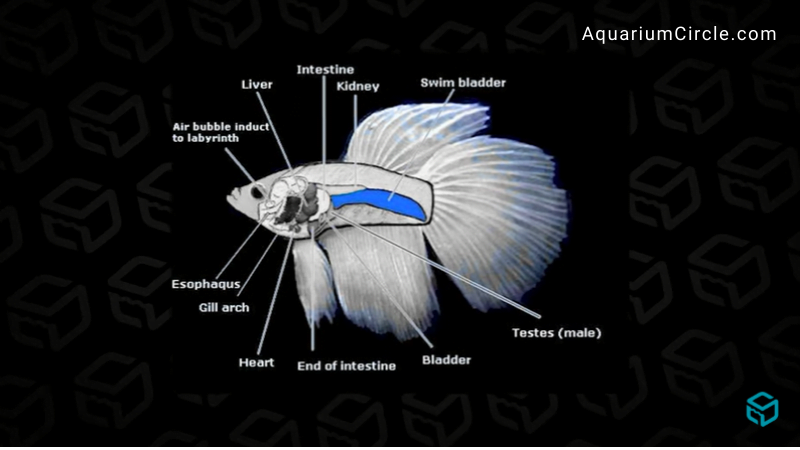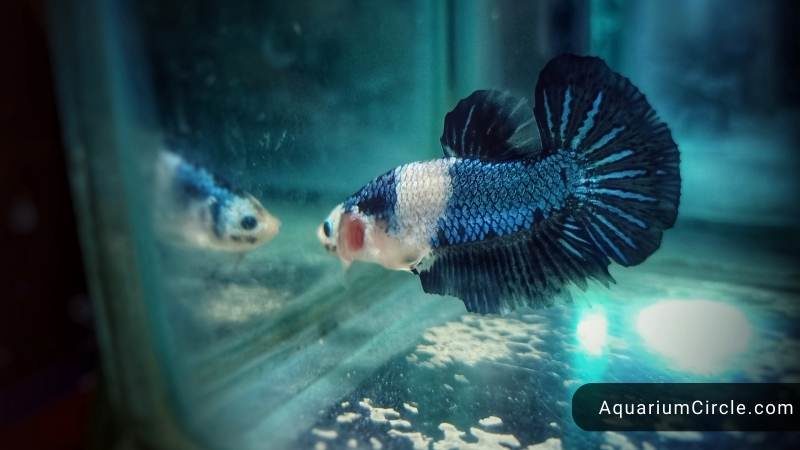Swim Bladder Disease (SBD) is a common ailment among betta fish. It is caused by various factors, including poor water quality, overfeeding, genetics, and bacterial infections. This article will show you some helpful information right below.
What Is Swim Bladder Disease Betta?
Aquarium fish frequently suffer from swim bladder disease, commonly known as swim bladder condition or flip over. The swim bladder is an internal gas-filled organ that helps fish maintain their buoyancy and avoid wasting energy swimming. Fish may stay at the present water depth. A fish with a swim bladder issue may show some signs of swimbladder-like fish often floating up or down in the aquarium, or it may float nose down or tail up.
Aquarium fish frequently contract swim bladder disease, which causes the bladder to malfunction and cause the fish to swim backward. Various things may bring on this condition, including physical anomalies, environmental conditions, mechanical issues, and inbreeding in some species. Goldfish and bettas are frequently reported to exhibit this disease. When this component is compromised, it will have an impact on how they move through the water and balance themselves, which is crucial to how they stay afloat.

What Are The Symptoms Of Swim Bladder Disease Betta?
Betta swim bladder disease causes them to have swim bladder problems, float on the surface of the tank or sink to the bottom, lose their balance and coordination, betta fish swimming sideways, and lose their appetite. Swim bladder illness in betta fish can also cause outward signs like an enlarged abdomen or a bent spine.
In severe circumstances, the fish can experience respiratory problems or lose the ability to swim altogether. It is significant to remember that these symptoms may also be a sign of other medical conditions, making a correct diagnosis crucial.
What Are Popular Causes Of Swim Bladder Disease Betta?
A number of things are common causes of the swim bladder, including overfeeding, a poor diet, parasites, constipation, genetic susceptibility, and poor water quality, which can lead to swim bladder disease in betta fish. A buildup of food in the digestive tract brought on by overeating might cause a swim bladder.
Swim bladder problems can also result from a poor diet deficient in critical nutrients. Constipation can cause the swim bladder, and bacterial infections and parasites might harm it or the nearby organs. Betta has swim bladder illness can potentially be because by poor water quality with high amounts of ammonia or nitrite. To prevent swim bladder illness in bettas, it’s critical to maintain adequate water quality, offer a balanced diet, and refrain from overfeeding.
- Digestive problems
- Coldwater Shock
- Swollen abdominal organs
- Bacterial and parasites
- Physical trauma
- Birth defects
- Poor food quality
- Constipation
- Kidney cysts
- Inherited trait
- Overfeeding
For some other causes, it’s possible that none of the aforementioned factors contributed to swimming bladder disease in bettas. In this situation, you should look for additional conditions such as egg binding in female bettas, cotton fin fungus, and other things because these are also issues. But, you should be aware that if this is the case, there is no way to treat betta has swim bladder disease; your only options are to wait and see how things develop, then seek the advice of a veterinarian if things worsen.
What Are Treatments Of Swim Bladder Disease Betta?

Obviously, you have to find out how to cure your swim bladder, especially when you know about how it can harm your bettas. Here are 03 types of treatment that match 03 popular problems you may have. We need the bettas to stay healthy.
Treatment for Betta has gastrointestinal problems.
It’s critical to address the root reason if your Betta has digestive issues. A typical remedy is to have the fish fast for a day or two so that its digestive system can relax and heal. After this time, you can start feeding your pet high-quality, easily digestible food like brine shrimp or bloodworms in tiny, regular portions.
Maintaining appropriate water quality in the tank is also essential because low water quality can exacerbate fish digestion problems. The tank environment may be kept healthy for your Betta by doing routine water changes and monitoring for ammonia, nitrite, and nitrate levels.
In rare instances, salting the aquarium might aid fish with digestive issues and minimize swelling in their digestive tracts. But, it’s crucial to use aquarium salt properly and to stay away from overdosing, which could endanger the fish.
It might be important to speak with a veterinarian who specializes in fish health if Betta’s condition does not improve with these interventions or if it exhibits symptoms of additional health problems.
Treatment for Betta has an infection
You’ll need to conduct some investigation to identify the offending party if a bacterial or parasite infection is suspected of being the cause of the swim bladder illness. For instance, Swim Bladder disease symptoms can result from the parasite that causes fin rot.
If there is no evident explanation, treating the fish with a broad-spectrum fish-specific antibiotic (such as Maracyn II), which you may purchase from your veterinarian or online, can be successful.
It can be better to move your betta to a quarantine tank for treatment and keep it there while giving it antibiotics. This mostly prevents plants and other tank residents from coming into contact with the medicine. As directed by the manufacturer, administer the drug.

See more: 5 Most Expensive Betta Fish In The World
Remember that you must perform 25% water changes daily, and installing an air bubbler in the betta tank is advised. That’s the regular way to treat swim bladder disease. The majority of antibiotics decrease the quantity of dissolved oxygen in the water that is accessible for your betta. This is crucial to your betta’s health and recuperation if they have trouble coming to the surface for air due to buoyancy problems.
Some supportive therapies
While treating your betta fish, you should also consider which therapy can help your betta. We bring to you some suggestions that you can do:
- Keeping your filtration system in good shape lets you keep the water clear and free of potentially hazardous ammonia and nitrites. Make sure to perform partial water changes as necessary to keep nitrate concentrations under 20 ppm (parts per million). To lower the danger of extra stress and shock, avoid sudden adjustments.
- Your tank may benefit from the addition of a tiny amount of aquarium salt (not table salt) or stress coat to help with edema reduction, healthy slime coat development, and immune system improvement.
- Reduce the water level in the tank while your betta is healing to make it simpler for your fish to swim about and reach the surface for air.
- To lessen the amount of work your betta must use swimming, ensure sure the water flow is kept to a minimum to avoid the pressure on the swim bladder.
- Apply a tiny amount of stress coat to the area where your betta tends to float, with one part of his body constantly exposed to the air to prevent the growth of ulcers and skin and scale dehydration.
- If your betta is having trouble consuming food from the surface, your betta may need hand feeding.
How To Prevent Swim Bladder Disease?
Preventing is always better than cure, you know. So being informed about how to swim bladder disorder and how to avoid it is very important.
Bettas react strongly to poor water quality and sudden changes in water’s properties. Living in an unclean tank will stress your pet, weaken its immune system, and open them to parasites and bacterial attacks. Swim bladder disease can be avoided by maintaining a clean tank and doing periodic partial water changes. So that’s crucial to give you betta a clean water tank.
Your betta’s digestion and immune system will benefit if you keep the water temperature at 78 degrees Fahrenheit all the time. Prevent extreme temperature changes.
Only give your betta, high-quality food, and feed your fish any dried meals to your fish after soaking them briefly in tank water. This will assist them in pre-absorbing water and expanding prior to eating. Before feeding your betta any frozen meals, thaw them first.
FAQs
Can swim bladder disease go away on its own?
Yes. If shock is the root cause, swim bladder disease can indeed go. You can only provide your betta the best possible living conditions and give it time to heal in such a situation.
Is swim bladder disease contagious?
Is swim bladder disease fatal? Yes. But depending on the cause, swim bladder illness may or may not be communicable. For instance, SBD caused by a parasite or bacterial infection in your betta fish might spread to other fish.
What does swim bladder disease look like?
In a fish with swim bladder disease, common anomalies include incorrect posture and position, a probable bulge on one side that could be the gas bladder itself or a tumor, skin sores from exposure to air or rubbing against substrate, and exophthalmos, sometimes known as “pop eye.”
References:
- Swim bladder disease – https://en.wikipedia.org/wiki/Swim_bladder_disease#:~:text=Swim%20bladder%20disease%20is%20a,due%20to%20fishes%20being%20inbred.
- Swim bladder disease treatment – https://www.petmd.com/fish/conditions/respiratory/swim-bladder-disorders-fish

Annette M. Chaney is an experienced marine biologist with over 20 years of experience as an aquarist and fishkeeper. She started her first aquarium at a young age, filling it with frogs and goldfish obtained from the ten-cent pet store.
Annette grew up caring for and breeding African Cichlids, which led to a hobby in high school that doubled as a profitable means. Attending Reed College gave her time to solidify herself as an accomplished aquarium caretaker with an eye for sales. After that, from 2009 – 2013, she studied at Roger Williams University – one of the most prestigious universities for Aquaculture and Aquarium in USA. She is the founder of AquariumCircle since 2010.
